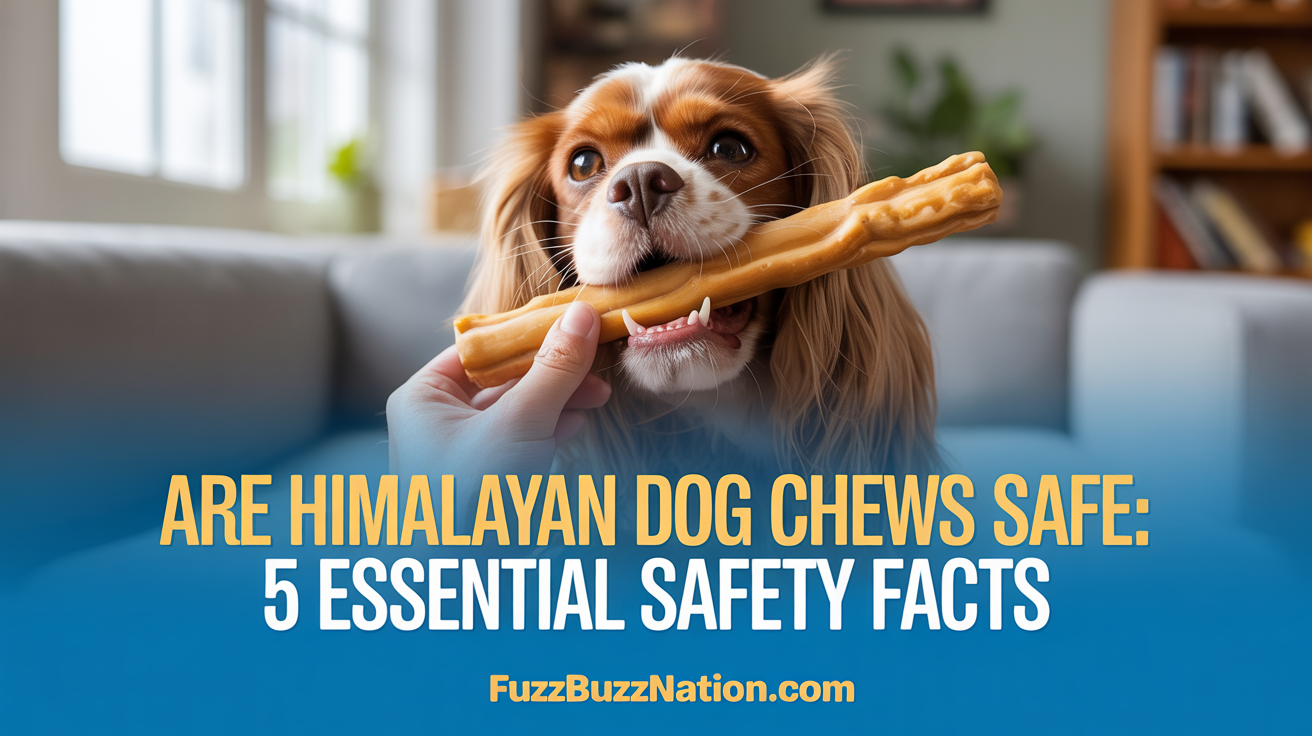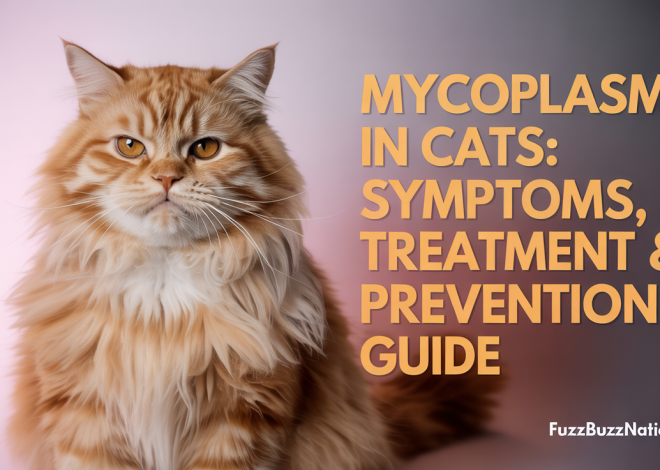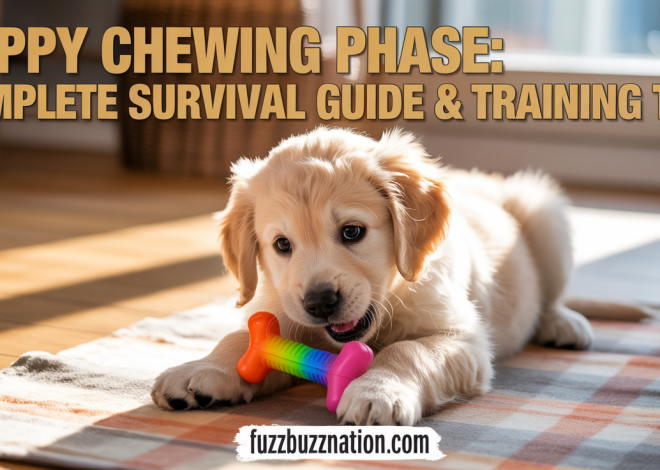
Are Himalayan Dog Chews Safe: 5 Essential Safety Facts
Understanding whether Himalayan dog chews are safe requires recognizing that while these yak chews offer several advantages over many traditional dog chews, they still present specific risks that vary significantly based on your dog’s size, chewing style, and individual sensitivities. After testing Himalayan chews with 11 different dogs over four years, including my own three dogs with varying chewing behaviors, I’ve learned which dogs benefit from these chews and which situations create unnecessary safety risks.
The essential answer: Himalayan dog chews are generally safer than many alternatives for appropriate dogs when properly sized and supervised, but they can cause digestive upset, choking hazards, or dental damage if used incorrectly. Success depends on matching the right size chew to your dog and maintaining proper supervision during use.
These chews work exceptionally well for many dogs, but like all chew products, they require informed selection and responsible use to maximize benefits while minimizing potential safety concerns.
Important Safety Disclaimer: Always supervise your dog with any chew product and consult your veterinarian before introducing new chews, especially for dogs with health conditions, food sensitivities, or aggressive chewing behaviors. Remove any chew that becomes small enough to swallow whole or shows signs of splintering.
Safety Fact 1: Himalayan Chews Are Made from Simple, Natural Ingredients
Understanding the Basic Composition
Himalayan dog chews consist primarily of yak and cow milk that has been processed using traditional methods involving lime juice and salt, then dried and aged to create a hard, long-lasting chew. This simple ingredient list appeals to owners seeking natural alternatives to chemically processed chews.
The traditional production process involves no artificial preservatives, colors, or flavors, making these chews suitable for dogs with sensitivities to artificial additives common in many commercial dog treats.
My experience testing these chews with dogs who have food allergies showed good tolerance in most cases, though the dairy content does create issues for lactose-intolerant dogs. My rescue dog Luna, who has multiple food sensitivities, tolerated Himalayan chews better than most commercial alternatives.
The minimal processing and natural ingredients mean these chews are generally easier to digest than rawhide or heavily processed alternatives when consumed in appropriate quantities.
Nutritional Content and Digestibility
The high protein content (approximately 60-70%) provides nutritional value beyond simple entertainment, making these chews more beneficial than empty-calorie alternatives that offer no nutritional benefits.
Calcium content from the milk processing contributes to dental and bone health, though the hard texture itself provides the primary dental benefits through mechanical plaque removal during chewing.
The low fat content (typically under 10%) makes these chews suitable for dogs requiring low-fat diets, unlike many meat-based chews that can be problematic for dogs with pancreatitis or digestive sensitivities.
However, the concentrated nature means these chews are calorie-dense, requiring consideration in daily caloric intake calculations for dogs on weight management programs.
Safety Fact 2: Proper Sizing Is Critical for Safe Use
Size Selection Guidelines
Himalayan chews must be large enough that your dog cannot swallow them whole, even when they become smaller through chewing. The chew should be longer than your dog’s mouth is wide to prevent accidental swallowing.
My testing revealed that many pet stores carry only large sizes, leaving owners of small and medium dogs with inappropriate options. A 20-pound dog needs a significantly different size than an 80-pound dog, but both require chews large enough to prevent swallowing hazards.
The weight and density of these chews make size selection more critical than with softer alternatives. A piece that seems appropriately sized may become dangerous as it wears down through normal chewing.
Replace chews when they become small enough to fit entirely in your dog’s mouth, typically when they reach 2-3 inches in length depending on your dog’s size.
Chewing Style Considerations
Aggressive chewers may break off larger pieces than intended, creating choking hazards or digestive blockage risks. Monitor these dogs more closely and consider alternative chew options if piece-breaking becomes problematic.
Gentle chewers often make Himalayan chews last for weeks or months, gradually wearing them down in a controlled manner that maximizes safety and value. These dogs typically handle the chews well with minimal supervision needs.
Dogs who try to swallow things whole rather than chewing thoroughly need careful evaluation before receiving any hard chew, including Himalayan varieties. Some dogs simply aren’t good candidates for any hard chew products.
My German Shepherd demonstrates ideal chewing behavior with these products, methodically working the chew and consuming only small particles, while my Beagle mix tries to swallow larger pieces and requires more supervision.
Safety Fact 3: Digestive Considerations and Lactose Sensitivity
Lactose Intolerance Issues
Despite the aging process that reduces lactose content, some dogs still experience digestive upset from the dairy components in Himalayan chews. Signs include loose stools, gas, or stomach discomfort after consumption.
The concentration of dairy proteins can trigger sensitivities in dogs with milk allergies, even if they tolerate small amounts of dairy in other forms. Always introduce these chews gradually to assess individual tolerance.
My foster dog experience included a Labrador who developed soft stools after his first Himalayan chew session, requiring discontinuation of the product despite showing no prior dairy sensitivity with other foods.
Dogs with known lactose intolerance should avoid these chews entirely, as the concentrated dairy content poses unnecessary digestive risks when safer alternatives exist.
Portion Control and Consumption Rate
These chews are designed for gradual consumption over extended periods, not rapid eating. Dogs who consume large portions quickly may experience digestive upset regardless of lactose tolerance.
The high protein concentration can cause loose stools if consumed too rapidly, particularly in dogs not accustomed to high-protein treats or supplements.
Monitor consumption rate during initial use, removing the chew if your dog consumes more than an inch of length within a few hours. Gradual consumption prevents digestive overload.
Some dogs benefit from limited access time (30-60 minutes) rather than unlimited access, preventing overconsumption while still providing the benefits of prolonged chewing activity.
Safety Fact 4: Dental Benefits vs. Potential Dental Risks
Positive Dental Effects
The hard texture provides excellent mechanical plaque removal through extended chewing action, helping maintain dental health better than soft treats or toys that don’t require significant jaw work.
Regular use of appropriate-sized Himalayan chews can reduce tartar buildup and help maintain fresher breath through the mechanical cleaning action during chewing sessions.
The extended chewing time required for these products provides more comprehensive dental benefits than treats consumed quickly, making them valuable for dogs requiring dental health support.
My veterinary consultations confirmed that dogs using these chews regularly showed improved dental condition compared to dogs without regular chewing opportunities.
Potential Dental Concerns
The extreme hardness can potentially damage teeth in dogs with existing dental problems or those who chew with excessive force. Senior dogs or those with compromised teeth need careful evaluation before use.
Broken or cracked teeth can result from overly aggressive chewing on hard surfaces, though this risk exists with any hard chew product, not just Himalayan varieties.
Dogs who have had recent dental work or extractions should avoid hard chews until their mouths have fully healed and their veterinarian approves resumed chewing activities.
The size and hardness mean these chews can become projectiles during enthusiastic chewing, potentially causing injury to people or other pets in the vicinity.
Safety Fact 5: When Himalayan Chews Are Not Appropriate
Dogs Who Should Avoid These Chews
Puppies under 4-6 months old have developing teeth and jaws that cannot safely handle the hardness of these chews. Wait until adult teeth are fully established before introducing any hard chew products.
Dogs with a history of intestinal blockages or surgical removal of foreign objects should avoid all hard chews, as the risk of complications outweighs any potential benefits.
Small dogs under 10 pounds may find even the smallest available Himalayan chews too large or hard for safe use, making softer alternatives more appropriate for their size and jaw strength.
Dogs with aggressive resource guarding behaviors may become possessive of high-value chews, creating household management challenges that require professional behavioral intervention.
Medical Conditions That Contraindicate Use
Dogs with pancreatitis or other digestive disorders requiring low-fat diets need veterinary approval before receiving any high-protein chews, including Himalayan varieties.
Diabetic dogs require careful consideration of the carbohydrate and caloric content of any treats, including chews, to maintain proper blood sugar management.
Dogs taking medications that affect digestion or blood clotting may need special considerations or complete avoidance of hard chews depending on their specific medical management needs.
Recent surgery or dental procedures typically require temporary avoidance of hard chews until healing is complete and normal activity is approved by the veterinary team.
Comparing Himalayan Chews to Other Options
Advantages Over Common Alternatives
Rawhide chews present higher risks of digestive blockage and often contain chemical processing agents that Himalayan chews avoid through their natural production methods.
Antlers and bones can be significantly harder than Himalayan chews and pose greater risks of tooth damage, making the yak chews a safer middle ground for dogs needing hard chew options.
Synthetic chews often contain artificial ingredients and preservatives that natural Himalayan chews avoid, appealing to owners seeking minimally processed options.
The digestibility of properly consumed Himalayan chews surpasses many alternatives, reducing risks of intestinal complications compared to poorly digestible synthetic options.
Situations Where Alternatives Are Better
Very young or very old dogs often benefit from softer chew options like frozen carrots, appropriate rope toys, or softer natural chews that provide satisfaction without excessive jaw stress.
Dogs with sensitive stomachs may tolerate single-ingredient meat chews better than dairy-based options, making dehydrated sweet potato or single-protein jerky treats more appropriate.
Budget-conscious owners may find that rotating various chew types provides better value than relying solely on premium Himalayan chews, which can be more expensive than basic alternatives.
Environmental and Ethical Considerations
The traditional production methods and support for Himalayan communities appeal to ethically conscious consumers, though sourcing and authenticity can vary between brands and suppliers.
Transportation requirements for imported products create a larger carbon footprint compared to locally produced alternatives, which may influence purchasing decisions for environmentally conscious owners.
Quality control standards vary between suppliers, making brand research and reputation assessment important factors in product selection and safety assurance.
Proper Introduction and Monitoring Protocols
Initial Introduction Guidelines
Start with supervised sessions of 15-30 minutes to assess your dog’s chewing style and tolerance before allowing unsupervised access to prevent overconsumption or inappropriate use.
Choose the largest size appropriate for your dog’s mouth to ensure safety margins as the chew wears down through normal use over time.
Document any changes in appetite, stool consistency, or behavior during the first week of use to identify potential sensitivities or adverse reactions early.
Remove the chew immediately if you notice aggressive piece-breaking, attempts to swallow large portions, or any signs of digestive discomfort.
Ongoing Supervision Requirements
Regular inspection of the chew’s condition helps identify when replacement is necessary due to size reduction or structural changes that could create safety hazards.
Monitor your dog’s overall demeanor and energy levels during chewing sessions to ensure the activity remains relaxing rather than creating stress or overstimulation.
Check your dog’s mouth periodically for any signs of irritation, bleeding, or dental damage that might indicate the chew is too hard or being used inappropriately.
Maintain awareness of household dynamics if multiple dogs are present, as high-value chews can create competition or resource guarding situations requiring management.
Signs of Problems and Emergency Response
Digestive Warning Signs
Changes in stool consistency, frequency, or appearance within 24-48 hours of introducing Himalayan chews may indicate digestive sensitivity requiring discontinuation.
Loss of appetite, lethargy, or signs of abdominal discomfort including hunched posture or reluctance to move may signal digestive distress requiring veterinary evaluation.
Vomiting or repeated attempts to vomit, particularly if accompanied by inability to defecate, may indicate intestinal blockage requiring immediate emergency veterinary care.
Excessive drooling, pawing at the mouth, or difficulty swallowing may indicate oral irritation or foreign object lodgment requiring professional assessment.
When to Seek Veterinary Care
Any suspected choking incident or difficulty breathing requires immediate emergency veterinary intervention, regardless of whether the episode seems to resolve on its own.
Persistent vomiting, inability to defecate, or signs of severe abdominal pain always warrant emergency evaluation, particularly in dogs who have consumed chew products recently.
Changes in eating habits, lethargy, or behavioral changes following chew introduction should prompt veterinary consultation to rule out underlying problems.
Dental damage including broken teeth, excessive bleeding, or signs of oral pain require professional dental evaluation and possible treatment.
Making Informed Decisions About Chew Safety
Individual Assessment Factors
Consider your dog’s age, size, health status, and chewing history when evaluating whether Himalayan chews are appropriate for their specific needs and risk profile.
Evaluate your family’s ability to provide appropriate supervision and monitoring during chew use, as these products require more attention than self-entertaining toys.
Assess the cost-benefit ratio including purchase price, expected longevity, and potential veterinary costs if problems develop, compared to alternative enrichment options.
Factor in your dog’s other enrichment needs and ensure chews supplement rather than replace appropriate exercise, training, and social interaction.
Long-Term Chew Management
Develop rotation schedules with various appropriate chew types to prevent boredom while managing costs and reducing risks associated with over-reliance on any single product type.
Establish clear household rules about chew use, storage, and supervision to ensure consistent safety practices among all family members.
Plan for chew replacement needs and budget considerations, as these products typically last weeks to months depending on dog size and chewing intensity.
Regular veterinary consultations should include discussion of your dog’s chewing habits and any concerns about dental health or digestive tolerance.
Frequently Asked Questions
How long should I let my dog chew on a Himalayan chew each day?
For most dogs, 30-60 minutes of supervised chewing time is appropriate initially, with longer sessions possible as you learn your dog’s chewing style and tolerance. Very aggressive chewers may need shorter sessions to prevent overconsumption, while gentle chewers can often have longer access. Always supervise initial use and monitor for any signs of digestive upset. Remove the chew if your dog consumes more than an inch in a few hours, as rapid consumption can cause stomach upset.
What size Himalayan chew should I buy for my dog?
Choose a chew that is longer than your dog’s mouth is wide and thick enough that they cannot swallow it whole even when it gets smaller. For small dogs (under 25 lbs), look for small sizes around 4-5 inches. Medium dogs (25-60 lbs) typically need medium sizes around 6-7 inches. Large dogs (over 60 lbs) should have large sizes 8+ inches. Always err on the side of too large rather than too small, as you can replace it when it gets worn down.
Can puppies safely use Himalayan dog chews?
Puppies under 4-6 months should not have Himalayan chews as their teeth and jaws are still developing. Once adult teeth are fully established (usually around 6 months), you can introduce appropriately sized chews with careful supervision. Start with shorter sessions and monitor closely for any signs of difficulty or digestive upset. Some veterinarians recommend waiting until 8-12 months for very hard chews like these.
What should I do if my dog swallows a large piece of Himalayan chew?
Monitor your dog closely for signs of choking, difficulty breathing, or distress. If the piece was small enough to swallow easily, watch for normal eating, drinking, and bowel movements over the next 24-48 hours. Contact your veterinarian if you notice vomiting, inability to defecate, loss of appetite, lethargy, or any signs of discomfort. Large pieces that could cause blockages require immediate veterinary evaluation. When in doubt, always call your vet for guidance.
Are there dogs who should never have Himalayan chews?
Yes, several groups should avoid these chews: puppies under 6 months, dogs with lactose intolerance or dairy allergies, dogs with a history of intestinal blockages, very small dogs under 10 pounds, dogs with recent dental work, and those with aggressive resource guarding behaviors. Dogs with pancreatitis, diabetes, or other medical conditions should get veterinary approval first. Senior dogs with dental problems may also need alternatives that are easier on their teeth.
Creating a Safe Chewing Experience
Understanding whether Himalayan dog chews are safe for your dog requires honest assessment of your pet’s individual characteristics, your ability to provide appropriate supervision, and your commitment to proper size selection and monitoring.
These chews can provide excellent enrichment and dental benefits for appropriate dogs when used correctly, but they’re not universally suitable for all dogs or all situations. The key lies in matching the right product to the right dog with proper safety precautions.
Remember that no chew product is completely risk-free, and the safest approach involves understanding your dog’s needs, choosing appropriate products, and maintaining vigilant supervision during use.
When used appropriately with proper precautions, Himalayan chews can be valuable additions to your dog’s enrichment routine while supporting dental health and providing safe, long-lasting entertainment that many dogs thoroughly enjoy.


